2019 Reflections
From July 8 to 18, 2019, the Institute for Advanced Jesuit Studies is led its sixth cohort through Spain and Italy as part of an immersion course offered through its Certificate in Jesuit Studies program. The Institute welcomed 20 participants--Jesuit scholastics and laywomen and men–from Europe and the Americas.
You can follow their shared experiences here through their daily reflections and photographs. Each day has a theme and selected readings as the travels progress from the early Jesuits' Iberian roots through the Ignatian legacy. As with past reflections, these reflections will be updated as the participants travel.
July 17
Rome
We began our morning again in the black taxi cars. Rolling along the rough Roman roads, we quickly reached our destination for Mass at Sant’Andrea al Quirinale. Though another work by Bernini, this church named for Saint Andrew was of an oval shape, with the entrance and the altar opposed on the short axis with the various chapels spread out across the longer axis. Bernini was said to spend many hours at the end of his life praying in this space. The main altarpiece shows a painting of the martyrdom of St. Andrew, and above is a sculpture of the exaltation of the same saint, rising to join the Holy Spirit in the center of the domed ceiling.
Our Mass was a simple one, again presided over by Fr. Casey with assistance from Fr. Barton, Fr. Patrick, and our enthusiastic deacon, Ramesh. As Fr. Casey delivered another poignant homily, he directed us to the artwork around us for inspiration and guidance. He gestured to the morbid and earthly martyrdom of St. Andrew, depicted upon his eponymous cross. He had us consider the importance of Andrew’s martyrdom and exaltation in the same space: that, like Andrew, we must avoid the temptation of the Evil Spirit to dwell only on either the “muddy” reality of this earthly plane or the transcendent reality of the Kingdom of God. As Fr. Casey put it, if we truly want to bring “on earth as in heaven” we must engage in a kind of “spiritual hovering”, meaning that we must navigate and make real such spaces between earth and heaven, that engage learning and spirituality - especially as those involved with the work of education.
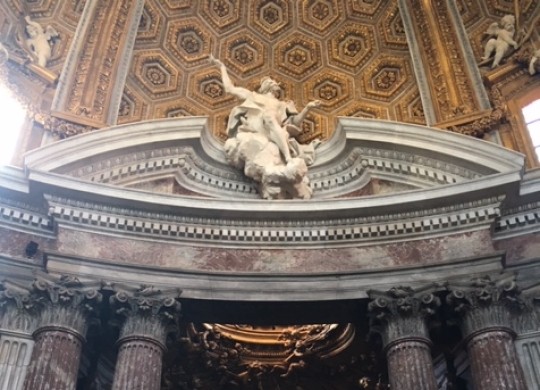
After Mass, we continued to the room of St. Stanislaus Kostka, whose chapel stood off to the right of the altar. Before reaching the room where the young Jesuit saint lay in agony and breathed his last, I was struck by the proximity of the old Jesuit novitiate to the church of St. Andrew, and was reminded of something back stateside. The former Jesuit novitiate in New York State was also named after St. Andrew (St. Andrew-on-Hudson, before it was closed), and there seems to be a common patronage of novitiates for the “first called”, meant to inspire novices in their discernment. The Society of Jesus would have been very desirous to establish good models of holiness for their novices and would be quite pleased by the working of the Holy Spirit to provide three apt examples in a triad of young Jesuit saints.
As we entered the room, we were reminded by Fr. Barton that Kostka was an excellent example of making a good discernment. In addition, he explained that the young Jesuit saints - Kostka, followed later by St. Aloysius Gonzaga and St. John Berchmans - show that discernment is not a prediction of the future. These young men, some of whom died before taking vows, are models of discerning and desiring the will of God, even if the ultimate completion of the act is not realized. Rather, a good discernment shows that God does not call us to be successful; God calls us to be faithful.
From there, we walked with our guide Daniella to Sant’Ignazio Church. After a considerable time admiring the church of St. Ignatius, we were led up a winding stairs to the top of the old Roman College to the rooms of the remaining two young Jesuits saints, St. Aloysius Gonzaga and St. John Berchmans. While both Kostka and young Luigi were noblemen who forsook the wealth and status that their families had planned for them, Berchmans was from a family of more modest means. Walking through the rooms of these two boy saints, seeing where they lived, worked, prayed, and eventually died, was a small insight into the life of those early Jesuit novices.
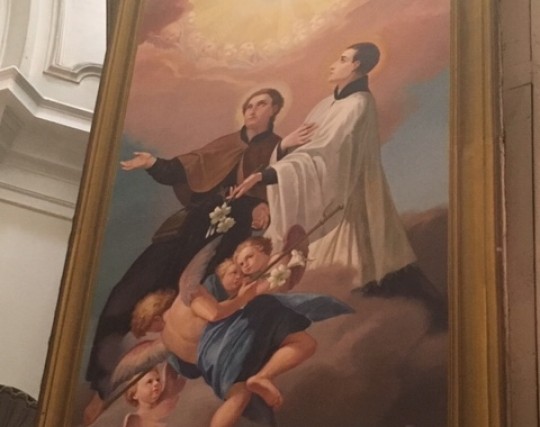
After returning from these high chambers in the old Roman College, we said our heartfelt and final goodbyes to our guide Daniella, and set off for the current Roman College, the Pontifical Gregorian University, and its trove of archival materials. We were briefed by an expert staff, led by Fr. Martín María Morales, S.J. about the size and scope of their unique project in the Gregorian archives. A wealth of materials had come into their possession: a collection of over five thousand manuscripts and letters from different stages of the Society of Jesus, from the spiritual writings of Pierre Favre to re-bound manuscripts of the Spiritual Exercises. All told, the staff of three experts have their work cut out for them. The task of cataloguing, transcribing, annotating, translating, and employing any of this collection is beyond herculean. This wealth of resources has only begun to be harvested within the last twenty years, with scholars of Jesuit sources from around the world offering to make what small progress then can on this titanic project. Fr. Casey was particularly excited for the Institute of Advanced Jesuit Studies to engage in this process as Fr. Morales displayed the digital archival feature which promises to invite collaboration from other scholars around the world. However, as we exited the building, the feeling was that the completion of even a small part of the project would take a time without estimation.
Today’s excursions took us on an overview of past and future. The young Jesuits who discerned their call to follow God were merely three of many that would serve the Society as best they could. The work of the small team led by Fr. Morales promises to be a basis for which the Society can better access and understand its roots by returning to the texts which so heavily influenced and formed it for today. The challenge of we who labor with the Society will be to be in balance somewhere between the two, as fellow members in formation as well as those who seek to better elucidate the work of the Jesuits. We have a lot of work to do when we get back!
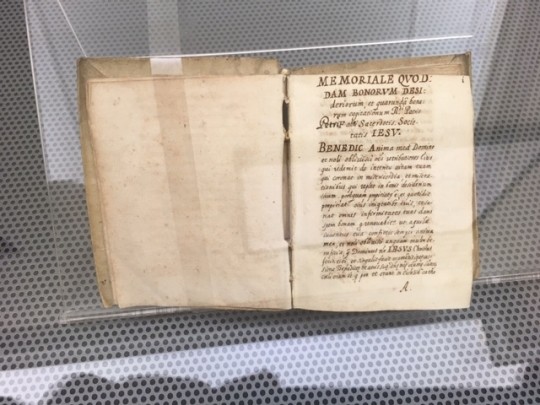
– John Giachetta, Msgr. Farrell High School, New York, NY
July 16
Rome
The black taxis take us to Santa Maria Maggiore, known to westerners as St Mary Major. This Basilica is full of wonder and awe and was designed by Bernini who is buried in the church. There is a simple inscription to the local boy. Here we celebtated mass in the side chapel above the spot where Ignatius celebrated his first mass as a priest on Christmas night 1538. There was a crib here and he dedicated his mass to Mary.
It is a Sistine Chapel decorated with marble taken from the Pallotine Hill. The remains of Pius V is peacefuly lying underneath, and a smiling sculpture of the pope looks down on us all. He seems to approve.
Fr. Pat, assisted by Ramesh, said the mass and Fr. Casey delivered his daily homily. He reminded us of our dreams, desires, and visions, and that as we mature we need to continue carrying these dreams, visions, and desrires with us. He asked us not to be lukewarm in doing so. We need to be Christ Bearers (Christophers).
Our calm tour guide, Daniela, took us on a tour of the Basilica and pointed out the beautiful mosaic of Mary and Jesus. It depicts Mary and Jesus sitting on the same level and Jesus crowning her. There are doves at their feet and they are both attended by choirs of angels. We also saw statues of “Maria Salus Populi Romani” and “Maria Regina Pacis.” In the latter she looks worried and is appealing for peace. The presence of Jesus in the company of Mary is evident. She is the first “christophoros”.
Then we drove to the building that houses the Jesuit Archives. Maria is the archivist and she labours alone but clearly loves her work. She joyed in explaining all the archives, letters and records. The place is truly remarkable and a wonderful resource. Ignatius was very clear from the beginning to keep records and the tradition continues today. This is a fascinating place for researchers and scholars who can play with the moving shelves, if they get bored. However penitent pilgrims might not be so excited.
On the way to lunch some followed Matt to Cappella Contarelli where we saw three wonderful paintings by Caravaggio - the Calling of Matthew, the Inspiration of Matthew, and the Martyrdom of Matthew.
After lunch we went to the Jesuit Curia, which is located near the Vatican. There we met Fr. Antoin, the Secretary to Fr. General. He addressed us and told us about Fr. General’s emphasis on communication and collaboration with other organisations.
After Fr. Antoin’s departure there was an opportunity for reflection and sharing. One member said that it was alright to love your neighbor as yourself, but first you must love God. Some talked about their gratitude for having time to recollect and that prayers are not merely words, no matter how finely composed, but payers must come honestly from the heart. Some concern was expressed at two sculptures on the facadae of the Gesu - one depicting Ignatius stepping on a clearly upset woman and the other of Francis Xavier stepping on a pained “Moor”. There were no further comments on this matter.
Then we went to Castel San Angelo, the mausoleum of the Emperor Hadrian (the guy that built the wall between Scotland and England), a prison, and a refuge for popes in times of danger. The view from the top is extraordinary, allowing visitors to see the Vatican, the Pantheon, various churches, and the beauty of the city.
– Lisa Soprano McQuaid Jesuit, Rochester, NY
– Daniel O’Connor Gonzaga College SJ, Dublin, Ireland
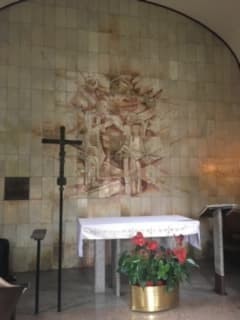
JULY 15
Rome
“Ciao!” from Rome. We cozied into three vans to navigate through light rain and heavy traffic to La Storta, outside of Rome. We found ourselves in a small, unassuming chapel which has great significance to our pilgrimage and to the early Society of Jesus. It is here that Ignatius had something akin to an intellectual vision. Ignatius asked that Mary place him with her son. Christ said to Ignatius: “I will be propitious to you [all] in Rome.”
It makes great sense that La Storta be our first stop as it was for Ignatius, Lainez and Faver. As we sat in the intimate chapel and heard a bit more about the history, we explored several formative dynamics in the early Society. For example, we wondered what it meant for Jesus to be “propitious” to them. What awaited them in Rome? We spoke of tribulations that ultimately led to trial and vindication. Among the worst trials of these early companions were the false accusations that came from a few who had left their ranks. Another intriguing dynamic involved the disagreements among the early companions as to their name: Were they the ‘Society of Jesus’ or were they the ‘Society of the Holy Name of Jesus’? Ignatius definitively affirmed the former.
Some of us wondered how it was that Ignatius had regular contact with the Pope even as accusations were flying around Rome regarding their orthodoxy and spiritual practices. Perhaps the years of diplomacy as a page and courtier served him well in this regard. It also occurred to us (Thanks, Fr. Bart!) that it was no accident that Ignatius brought Lainez, the great theologian, from Paris with him to Rome. So with this stop we were able, as Fr. Casey suggested, to see reverberations of these early dynamics in the future Society.
Our next stop was to St. Paul Outside the Walls. Our tour of this magnificent Roman basilica included the gilded flowers of the ceiling, mosaics of our 226 popes, and the crypt of St. Paul the Apostle. Most notable for our pilgrimage was the Chapel of Our Lady where six Jesuits professed their vow of obedience to their newly elected Superior, Ignatius. Once again, we appreciated the devotion Ignatius and his companions to Mary.
The mid-afternoon began with the opportunity to check in with one another. We named consolations from our time in Spain and hopes for our days in Rome. It was evident that the Good Spirit was active among us and that at the same time we were tuned to the working of the Enemy our Human Nature. From there we walked to the Gesu Church. Each step en route provided us the chance to see the grandeur of Ancient Rome.
We were in awe of the stunning baroque masterpiece that is the Church of the Gesu—the grand paintings of the ceilings, the altar to Madonna Della Strada (Our Lady of the Street) and especially the tomb of St. Ignatius. Before we went to see the rooms of St. Ignatius, we paused at the tomb of the so called “Second Founder of the Society of Jesus,” Fr. Pedro Arrupe.
Upon entering the rooms of St. Ignatius, we were filled with reverence not only for the sacred space in which we found ourselves but also the great care that Jesuits have given to preserving it over the centuries. What a privilege to see the shoes in which he walked the streets of Rome; the letters he wrote, stamped and signed to people across the world, and his final resting place. Wow. We were honored and awed to celebrate Mass in this upper room. We continue to grown in our understanding and appreciation of the Foundations of the Society.
– Edward Peck, John Carroll University, University Heights, OH
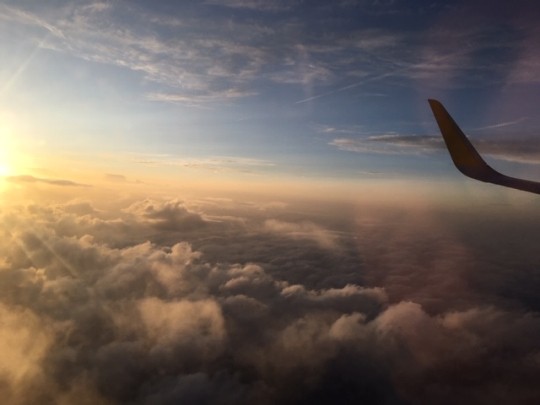
JULY 14
Barcelona, Rome
It is hard to believe that it is only a week since we all met for the very first time considering how close our group has become: there is a real sense of companionship and community. It is also hard to believe that our time following in the footsteps of St. Ignatius in Spain has come to an end and that tomorrow we start our second, and final, leg of the journey in Rome.
The theme for our seventh day was “Encountering the World in Barcelona”. After such a formative year (for both Ignatius and the future Society of Jesus) in Manresa, Ignatius came to Barcelona, alone, in 1523 to set sail on his pilgrimage to the Holy Land. He eagerly yearned to walk in the footsteps of Jesus. While in Barcelona he encountered supporters such as the noblewoman Isabelle Roser who became a benefactor and, like us, and many others, a spiritual follower of Ignatius. He returned to Barcelona in 1524 chastened by his time in Jerusalem. At this point he began his lengthy studies, recognising the need for personal intellectual development to support his own spiritual development, which would thus benefit the spiritual development of his followers.
Our first stop today was to the Iglesia del Sagrat Cor (Church of the Sacred Heart) where we saw what is believed to be the sword Ignatius laid down at the altar of Our Lady in Montserrat after his (three day) general confession, and before he set off for Manresa. Here we also met our local guide Gregorio who would take care of us for the day.
Our next and especially memorable stop was the truly unique Sagrada Familia. We have already visited many awe-inspiring churches on this pilgrimage and will visit more before it is over. But what made the Sagrada Familia stand out is that it is not a gorgeous relic of Church history from centuries ago; rather, it is still being built. It serves as a reminder that our Faith is alive, and it is possible for Catholics today to metaphorically and literally build for future generations.
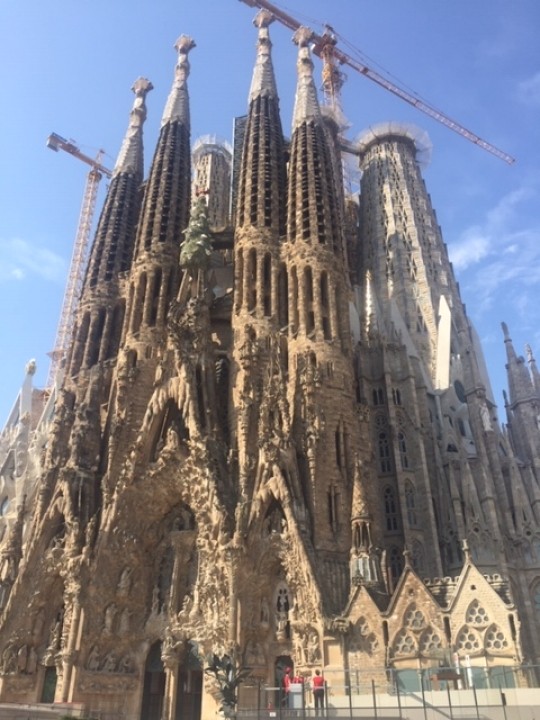
From here we moved to the old city via Las Ramblas. It was really interesting, and even a bit overwhelming, to move through the hustle and bustle of the people of Barcelona and the many, many tourists on a typical Sunday afternoon as we headed towards our next destination; the Basilica de Santa Maria del Mar. In this gothic basilica we looked upon the modern statue of St. Igantius begging for alms on the spot where he himself would have sat begging for alms in 1524-25. After we had visited the little chapel of St. Ignatius beside the north entrance we moved to a small chapel behind the main altar to celebrate mass.
During his homily Father Casey drew a connection between the Sagrada Familia and the work of Jesuits and Ignatian educators today. Pointing to the Sagrada Familia's solid foundation of the traditional crypt (built early on) and its exuberantly imaginative main structure, Father Casey noted the importance of drawing from the foundations of the Society of Jesus as we build creatively for the future. If we look to Ignatius's writings and works and strive to understand the first Jesuits properly, that will provide much needed guidance. That is a blessing provided by this pilgrimage: the opportunity to deepen our understanding of the foundations of the Society of Jesus and then to apply that understanding to how we live our lives and how we approach our work in Jesuit education.
As we said thank you and goodbye to our wonderful guide Yolande we clambered aboard our flight to Rome wondering what lies ahead for us. We have to think about Ignatius arriving in Rome ready to embark on the next stage of his pilgrimage: the founding of the Society of Jesus.
– Aoife Dunne, Gonzaga College SJ, Dublin, Ireland
– Brendan Graves, Jesuit High School, Tampa, Florida, USA
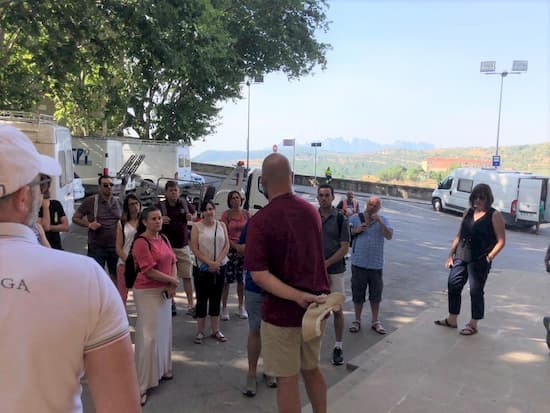
JULY 13
Barcelona, Manresa
After waking up in Barcelona, we drove down the winding mountain road down to Manresa. While St. Ignatius spent 10 months in Manresa, we squeezed several of the most significant places of his time there into 8 hours!
We gathered for Mass in the Cave that St. Ignatius began to write what became his Spiritual Exercises. During his homily, Fr. Casey Beaumier, SJ, invited us to have the receptivity in our prayer in a way that St. Ignatius was open to Jesus and the Blessed Mother during his time in the cave. Before and after Mass, Fr. Bart Geger, SJ, related some of the experiences from the story of St. Ignatius at Manresa to prominent themes (discernment, imaginative prayer, and thinking with the Church) from the Spiritual Exercises. As he talked and Fr. Bart answered our questions, we were able make a composition of place from where we were standing on the terrace of the International Center for Spirituality built over the cave. We could see (and afterwards visit) the medieval bridge that St. Ignatius would have walked over, the River Cardoner where St. Ignatius would have prayed beside, and the Cathedral where St. Ignatius would have attended Mass and engaged in spiritual conversation.
Following visits to these places of prayer, we stopped by Santa Lucia Hospital where St. Ignatius served the poor and sick. Though part of the hospital and the chapel attached to it where destroyed during the Civil War, we were able to get a sense of the place where residents of Manresa would claim that St. Ignatius spent 8 days in rapture.
Our day closed with a delicious lunch in Manresa and a bus trip to Barcelona for our last night in Spain.
– Patrick Nolan, S.J., Boston College High School, Dorchester, MA.
– Brian Flannery, Irish Provence, Society of Jesus
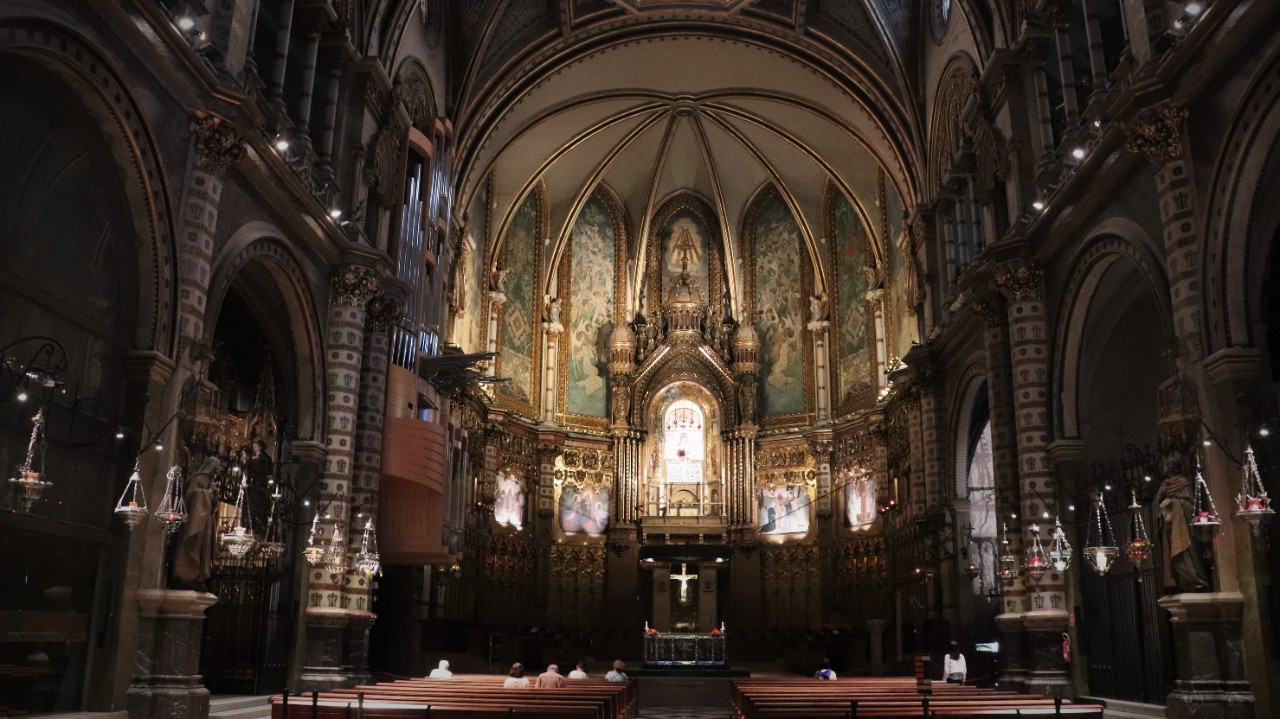
JULY 12
Montserrat, Barcelona
Today we woke up overlooking the astonishing mountain of Montserrat (or at least some of us woke up since the bells of the church rang the hours all through the night!). This is a place of indescribable beauty high high above the world, a perspective from the heavens.
It is no wonder that pilgrims and seekers have sought this place and climbed this mountain almost continuously since the 8th century. And now we arrive joining them and joining Ignatius the pilgrim when he was 31 years old (year 1522). It was after his injury and in the early stage of his conversion that he resolved to make a pilgrimage to the Holy Land in order to pledge his life to God. Departing from his family home at Loyola he traveled the rough and winding roads of northern Spain (then Aragon) a distance of over 100 miles to the mountain monastery and shrine at Montserrat. Upon arrival he sought counsel from one of the monks, revealed his desire to serve God, and made a general confession of the sins of his entire life. Then, as he thought himself ready, he gave away his mule and fine garments and laid down his sword and dagger at the altar of Our Lady of Montserrat (the Black Madonna); a symbolic act of renunciation of his knighthood and former life. From Montserrat he journeyed next to the small town of Manresa where the graces of his initial conversion deepened (but that’s tomorrow’s story – stay tuned!).
For our little band of pilgrims this was a day of rest and reflection for some and a day of walking and climbing for others.
Gina, Noelle and Aoife took the funicula (cable car) up the steep mountain and then trekked down by foot stopping at the hermitage of St. Joan along the way.
Lisa, John, Jack, Kathleen, Ilse and Andrew made the vigorous climb to the top of the mountain and back down again on foot – a journey of 2-3 hours! Here is what the shared on arriving back at home base:
Lisa: (truly speechless) “When we arrived at the top it was a ‘coming together moment’ for me’ – both a culmination of life so far and the glimpse of a new horizon.” What touched me most was how we made the climb together!
John: “What touched me most was coming down the mountain because now I am challenged to share a truly wordless experience with others.”
Andrew: “What touched me was walking a path that so many pilgrims and hermits have traveled. I felt connected to the experience of the past – now this is no longer a story for me, it is real.”
Jack: “What touched me was being part of the group and supporting the others for whom the climb was a real challenge. It was such a physical experience of endurance and companionship calling to mind the journey that so many have traveled.”
Ilse: “What touched me deeply was the sacred sense of nature; the ancient earth that holds us (showing an amazing rock from the mountaintop that had once been at the bottom of the sea!). And also making the journey together; the bond of this shared experience and the traveling together.”
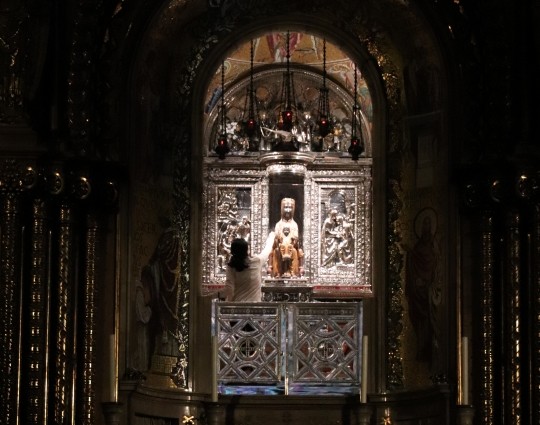
And finally, Ramesh took the winding pilgrim walk round about the mountain to the cave where the image of Our Lady of Montserrat was first discovered by a young shepherd boy.
Ramesh (after a few wrong directions along the way): “Sometimes you need to follow your heart to get down the mountain!”
Wisdom for pilgrims on the way!
– Monica Meagher, Marquette University, Milwaukee, WI.
JULY 11
Sos, Zaragoza, and Verdú
Our theme of the day is pilgrimage and discernment. In our first primary source reading for the day, from the 1550s by Luis Concalves de Camara, he explains, according to Ignatius, the utility in going on pilgrimage… Ignatius goes on to speak of the advantages of pilgrimage (at Manresa, etc.where we will arrive soon!) and why he was well suited to them. It is an endeavor that when done right, can create or enhance the conditions where some type of personal enlightenment can occur. Indeed, our gospel today, taken from Matthew, also speaks of “effective pilgrimage tactics”, when Jesus says to his disciples as they take to the road...
“Do not take gold or silver or copper for your belts; no sack for your journey, or a second tunic, or sandals, or a walking stick” as they are sent to spread the Good News.
I believe Ignatius tried mightily to take Jesus at his word, when he left for Manresa. Of course, including much of his time at Manresa, much of his early journey to Jerusalem involved the most austere of self-denial as he seemed determined to follow both the letter and spirit of the law of Jesus’ “pilgrim advice” to take nothing for the journey except full dependence and faith in the Holy Spirit. But in Ignatius’ later advice to de Camara, he goes on to say, “upon seeing how pilgrims became ill, etc., we moderated such practices and left it to the discretion of the superiors.” He realized that self-denial does can serve a wonderful experience of exploring one’s own interiority, but that more, more, more of it may not yield the Magis for many… our pilgrimage experience, if any sort of enlightenment is to occur within it, will be found more in the larger physical movements and regular contemplation of the pilgrim, and will not be arrived at primarily as a function of the degree of asceticism we inflict upon ourselves… to some that may be a fruitful approach to deepening the graces received from pilgrimage, but ultimately to each his or her own path of appropriate sacrifice to find the greatest grace and enlightenment.
Under our wonderful “superiors” of Fathers Casey, Bart, and Patrick we have moderated the experience quite nicely and we are certainly not being asked to sacrifice all the comforts in the way Jesus’ admonished the 12 or Ignatius chose as his unique path. As we woke up in Sos del Rey Catolico, we were treated to a sumptuous buffet feast, clearly our most “5 star” morning experience to date at our hotel, The Paradora.
But even within the context of the food being quite excellent and abundant on this trip, and while the BC immersion experience is clearly not forcing us to be deeply ascetic, there is still a kind of greater discipline to our dining. We eat three times a day at very specific times and there is very little snacking in between. We truly build our appetites to even Noelle’s level of “hangry” on occasion, from our active experiences between meals. But at these thrice daily “breaking of the bread,” this is where our hunger for both nutrition and companionship meet beautifully three times a day in the fruit of always an unexpected conversation to go deeper in relationship with a fellow traveler. It seems to organically occur with every sitting. We truly are experiencing what Father Greg Boyle, SJ, calls “table fellowship.” For instance, this morning I had a short but wonderful sharing conversation about my children with Kathleen. the kind of thing that needs a stationary moment in the pilgrimage to emerge over bread (in this case, the best tortilla we’ve had to date!) and I am thankful we have these moments in the start, middle, and end our days.
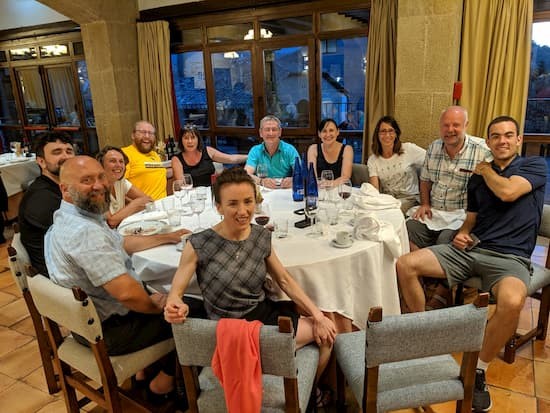
And perhaps we are also just starting, as a group, to effectively manage this trip ourselves, finding the sweet spot within, the Ignatian Spirituality theme of caritas discreta (discerning charity), meaning a thoughtful and prudent pacing of oneself in the service of God. Our meals, along with Mass each day, slow us down to bring us into balance and so that we can together process and integrate the ongoing flood of historical content as well as find the proper degree of alone time that each of us needs to get the most out of this experience. We simply must also live in the reality of our trip and to wish for others is to lose the opportunity to take a loving, if not long, look at the real in our contemplation. In any event, onward from food!...for now...VAMONOS!
After departing the beautiful medieval town of Sos Del Rey Catolico, we arrive at the breathtaking city of Zaragoza, the capital of Aragon. The main attraction in Zaragoza is the expansive Plaza de Pilar and the Basilica del Nostra Senor Del Pilar. The Lady of Pilar is a popular shrine for tourists and Spaniards alike. Legend has it, that Our Lady of Pilar came to St. James in an apparition and instructed him to build a church on the site in which the basilica now stands. Our Lady of Pilar is the patroness saint of Spain. Her feast day is on October 12th the national day of celebration for Spain, which coincides with the landing of Christopher Columbus in the Americas. The Virgin of Pilar is a symbol of Spanish pride, economic prosperity, and global expansion. In fact, flags from Spanish colonial countries of South America can be found hanging from the walls of the basilica. A triumphant tribute, unconsciously or not, to European Colonialism. Our commitment to Jesuit education and Catholic Social Justice left us critiquing the veneration of colonial Catholicism found within the walls of the Basilica of Zaragosa. We were left pondering many questions pertaining to the symbolism we found and the stories they perpetuate.What place do these flags have in the house of the Lord? Although these flags represent prosperity for Spain, what negative consequences did they produce for the indigenous communities of South America? Should Our Lady of Pilar be associated with the landing of Christopher Columbus in the Americas, a day that represents such a radically different set of outcomes for indigenous Americans then it does for Spaniards? As Andrew and Ed alluded to, the great Jesuit philosopher, Bernard Lonergan posits that authentic subjectivity leads to a genuine objectivity. We should always be searching for truth. As lay people, Jesuit brothers, and priests, we all have a responsibility to shine light on these questions and grapple with the answers, so that we may come to a thoughtful understanding on the nature of human relationships within the context of these particular power differentials.
Our next stop before retiring for the evening in Montserrat, one of the most important places in Ignatius journey, was in Verdu’, the home of Jesuit Saint Peter Claver, the patron saint of slaves. Peter Claver was a 17th century missionary to the New World. His primary ministry was to care for slaves coming from Africa and to convert them to the faith. It is said that upon a slave ships arrival to Grenada, Peter Claver would immediately board them and begin ministering to those who were brought over against their will. This was a ministry that few would undertake, given the stench and airborne sicknesses found in the overcrowded ships. Although Claver can be held up as a model of love and a promoter of human dignity, again we are left pondering the implications of European-Christian Colonialism. As much as Peter Claver did to love and serve African slaves, questions remain. Is there more Claver could have done to remedy the systemic injustices associated with Spanish colonialisms? If he spoke out, did he risk being removed by the colonial governments,further complicating the future of slaves in the region? As Catholics, can we be proud of the love Claver showed to the most vulnerable and angered that he didn’t do more to ameliorate slavery? Perhaps, he was just a man doing all he could for the most amount of people possible. The beautiful thing is that we, as Jesuit educators on pilgrimage, are asked to wrestle with these questions so that we may come to some graced understanding or, at the very least, invite our students to struggle these same complicated questions.
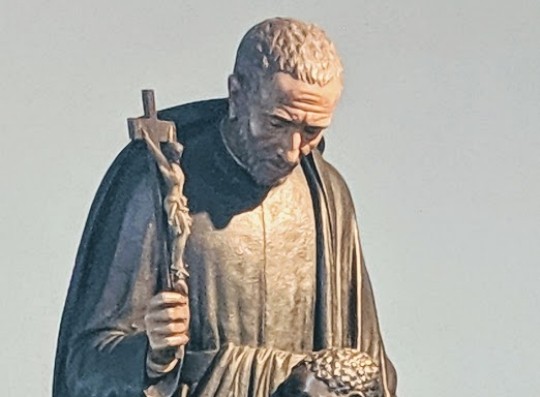
We conclude our day, taking comfort in the story Fr. Bart shared regarding the friendship between St. Peter Claver and St. Alfonsos Rodriguez. Alfonsus joined the Society after his wife and children died of cholera. He was deemed to be too old to begin theological training, so he was made a Jesuit brother. His ministry was to be the door keeper at the popular Jesuit residence in Majorca. Alfonsos was initially disappointed that he would live out his ministry not serving a more noble cause, however, he promised to treat every person who walked through the door as if he were Christ himself. People were so taken with Alfonsos' hospitality, that many started to visit the home to be touched by the doorkeepers tender love. One day, a young Claver walked through the residence. Claver was reluctant to take on the mission work to the Americas. It was Alfonsos who convinced him that it was what he ought to do. That authentic exchange led to a profound lifelong ministry for Claver. We say goodnight, reminded that we are called to fight for justice, and to do so with the love, hospitality, and respect for human dignity that guided the lives of Rodrigues and Claver.
Laybrother of the Society of Jesus
by Gerard Manley Hopkins
HONOUR is flashed off exploit, so we say;
And those strokes once that gashed flesh or galled shield
Should tongue that time now, trumpet now that field,
And, on the fighter, forge his glorious day.
On Christ they do and on the martyr may;
But be the war within, the brand we wield
Unseen, the heroic breast not outward-steeled,
Earth hears no hurtle then from fiercest fray.
Yet God that hews mountain and continent,
Earth, all, out; who, with trickling increment,
Veins violets and tall trees makes more and more
Could crowd career with conquest while there went
Those years and years by of world without event
That in Majorca Alfonso watched the door.
– Dino Pinto, St. Joseph’s Preparatory School, Philadelphia, PA
– Jack Ruppert, McQuaid Jesuit, Rochester, NY
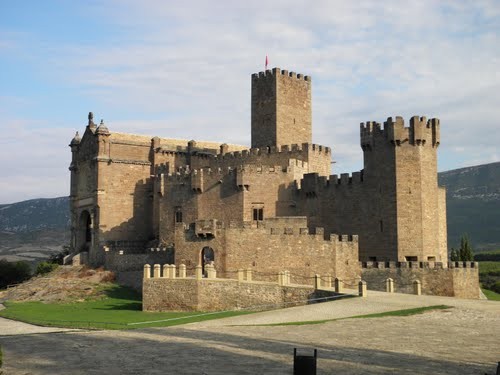
JULY 10
Aranzazu, Pamplona, and Javier
Today we stepped back in time to the late 13th / early 14th century with a visit to the Ermita de Olatz. This is the oldest hermitage in Azpeitia , restored in 2000 and the place where St Ignatius visited to pray to the Virgin of Orlatz.
Next is was on to the Franciscan run, sanctuary of Our Lady of Aranzazu, set in the Aizkori mountain range in the Onati area of Basque Country. This is a favourite with devotees of the Blessed Virgin Mary. The church is located in the site where the Virgin of Arantzazu appeared to the shepherd Rodrigo de Balanzategui in 1468. The story goes that Rodrigo was first attracted by the sound of a cow bell and on closer inspection saw the figure of the Virgin in a thorn-bush, and his exclamation "Arantzan zu?!" (Thou, among the thorns?!) gave rise to the name of the place which stems from "arantza + zu", 'place abounding in hawthorn'. The beautiful statue is depicted with a cow bell.
On to Pamplona in the Navarre region where Ignatius took up arms against the French in 1521. The place where he was subsequently wounded is marked by a plaque at the Iglesia de San Ignacio. Our visit coincided with the towns Feast of St Fermin, the running of the bulls festival and a popular stop off for those on pilgrimage.
Next on the list was Javier, where Francis Xavier was born in 1506. While Francis Xaxier and Ignatius birthplaces where geographically close they did not meet until both at the University of Paris. Javier boasts a tower dating back to the late 10th century and is set within beautiful views of the surrounding countryside.
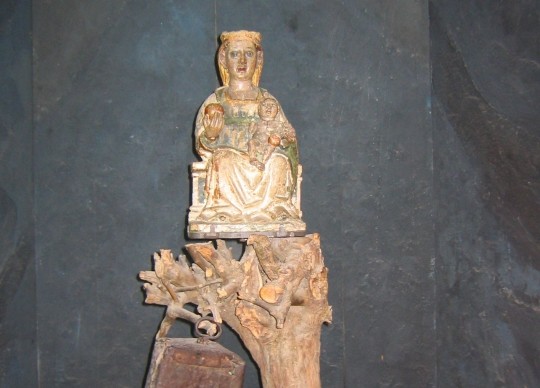
The Chapel of the Holy Christ is where the gothic statue of Christ of Javier can be found, a beautiful depiction carved in walnut.We finish the day at SOS del Rey Catholico in the Aragon region , birthplace of Ferdinand , one of the Catholic Monarchs.
– Ramesh Ernest Richards, S.J., School of Theology and Ministry, Chestnut Hill, MA.
– Noelle Russell, Belvedere College SJ, Dublin, Ireland
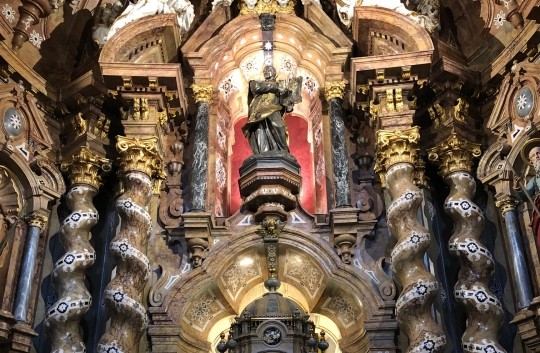
JULY 9 – EARLY IGNATIUS
Azpeitia
Even though we were standing in the very place where Ignatius was born and then where the discernment of spirits was born, it is hard to fathom the reality that took place in those two rooms. A painting that hangs in the room where Ignatius was born depicts the newborn in his mother’s arms. The plaque recounts the legend that Ignatius’s mum tried to get herself to the stable before giving birth so that Ignatius could be born in a manger just as Jesus had been born. It is astounding to think that Ignatius’s mum could have had premonitions about his connection to Jesus 28 years later, especially since she died soon after giving birth. Thanks to Ilse for pointing out that plaque! This is an example of where the lines between history and myth can be blurred.
The basilica in Loyola is a magnificent monument to the legacy of St. Ignatius and the Society of Jesus. An altar for Jesus and the Blessed Mother anchor either side of the extraordinary main altar. Other prominent Jesuit saints, like Francis Xavier and Francis Borgia, adorn the perimeter. Beneath a breathtaking dome, decorated with statues and coats of arms, every inch of the interior is exquisitely crafted from the finest wood and stone. Here, we may understand Andrew’s invitation to look beyond the mere “marvel of the physical” into a “wonder about the intention.” The basilica is a remarkable representation of the story of Ignatius’ conversion and founding of the Society.
Finally, the diorama gallery chronicles the major events of St. Ignatius’s life, from his birth through his death. It depicts all of the people, events, and encounters that ultimately led to the founding of the Society of Jesus.
Walking through the birthplace and childhood home of St. Ignatius underscored the reality that Ignatius, like each of us, was once a child and then an adolescent, and eventually matured into a person seeking how he might best fulfill the will of God. The example of his life challenges each of us to respond to God’s call in our lives.
– Matt Walsh, Scranton Preparatory School, Scranton, PA.
– Gina Smyth, Boston College High School, Dorchester, MA.
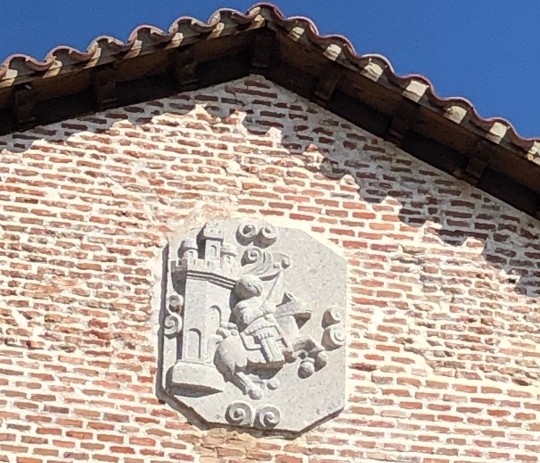
JULY 8 – OPENING CONVERSATIONS
Madrid
Our pilgrimage adventure starts by taking us from the bustling metropolis of Madrid to the farm village of Arévalo. Encountering model lives is how the Travel Companion Book for the pilgrimage starts. Indeed, it says, Ignatius’ decision to follow the example not of knights but of saints signifies the importance of models, guides whose previous paths can inspire, inform, and direct other toward unknown places and decisions. His example 500 years later helps us follow in his footsteps and discover how his pilgrimage can inspire us.
One of our discoveries today as we walked through Arévalo – where Ignatius served as a page for a major official to King Ferdinand – is how the chivalric codes that the young Ignatius was raised with were actually not so different for knights as they were for saints. Both priests and knights are asked to take up their arms “in as pure and devout a way as possible.” Both knights and priests should “lead honest lives” suitable for the high service for which they were ordained. Moreover, both were asked to live in this state so that they would be unafraid of their enemies, for the priest being the devil and evil spirit in their inner lives.
From the small village of Arévalo, we journeyed to Burgos. Here we learned of the religious situation of sixteenth century Spain. A special experience today was visiting Saint Nicholas Church in Burgos, the burial place of the Polanco family. We imagined ourselves in the footsteps of the Society’s first secretary, who in his days shaped such a distinctive characteristic of this unique religious order. He gathered and shared the “shattered experiences” of the First Companions, writing the opening chapters of what was going to be an ongoing narrative. The narrative spirituality invites us and others to give language to our experiences as we continue on our pilgrimage.
In addition to learning about Polanco’s work as secretary, we also delved into the religious tumult of Ignatius’ day. Polanco’s family was conversos, Catholics who had at one point been Jewish and converted either by choice or by force. The Inquisition and Spanish Catholics frequently looked down upon conversos as inadequate or unable to be truly Catholic. Despite this prejudice, Ignatius welcomed many conversos to the early Society, especially Polanco. Ignatius’ openness and welcoming spirituality perhaps offer a inspiration to those searching for meaning in a secularized world, but not always finding that welcome among the Catholic Church.
Our day ended by arriving in Loyola, looking out at the stunning basilica and anticipating praying and learning their the next day.
– Ken Homan, SJ, School of Theology and Ministry – Boston Colllege, Chestnut Hill, MA.
– Ilse Dekker, Director, Jesuit European Committee for Secondary and Primary Education, Netherlands


